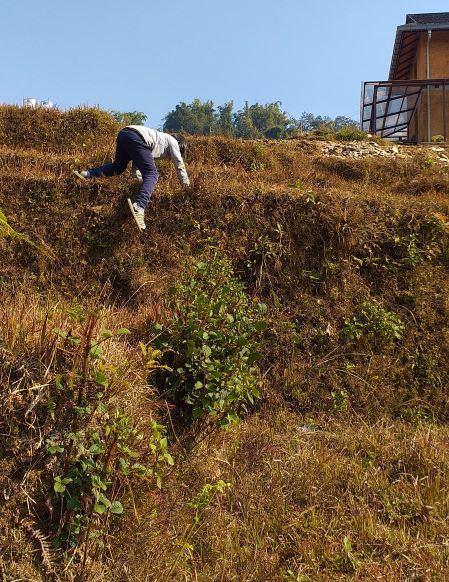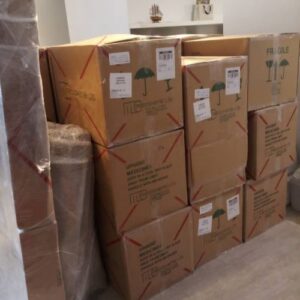The boundary confused with punctuation of wild bamboo is displaced with sounds of slashes and whips. The Jumla boys take a playful swing along the green branching clusters and tamed them with their axes and machetes, tugging the hollow culms up the terraces with their sheer strength, trimming them into workable lengths and shouldering them onto the stage to act as props for the drama of concrete pouring.
The backdrop was a well executed human chain – of gathering sand, gravel, chips and cement in wheelbarrow proportions, tipping them into the waiting and roaring contraption, its drum swivelling and spiralling drunkenly, ensuring its devoured concoction becomes a thick ashen brew that is ready to be sent lifting up 10 feet high. And there, up there on the precarious edge, the regurgitation of the brew is expelled into 2 waiting large wheelbarrows. Two men armed with a long wooden stick and handle – a makeshift trowel – would smoothen out the brew as the minced aggregate snuggle between grids of reinforced metal bars, woven within the ply formwork to become a fragment of an abode. The bamboo props the formwork sturdily like a trunk, holding the weight of the pouring without fuss, embracing a new kin into its hold. The orchestration played on for 6 hours like clockwork without a break. Then the skies opened up and rain graced the dust. The roaring drum came to a halt in need for a refuel, interrupting the show and giving in some quiet. The Jumla boys were forced to retreat momentarily, take a breather, steal in gulps of water, wipe their sweaty brows and count the minutes before the finale. The last 45 minutes of pouring went on swiftly as tired bodies resisted exhaustion. The stage lighting went out when the sun retreated for the day. Darkness took over.
It must have come to be that, that before entering the bowels of the rotating contraption, the grain of sand quivered with terror. It must have looked back at the path it travelled, from the shores of the Mardi River, the unforgiving winding roads crossing villages in mud-caked lorries. It was brought to a place, displaced with other mounds of gravel, chip and clay. And in there lay shovels and wheelbarrows and men and that frightful thunderous drum that breaks out into rolls of fury, its internal blades churning and whipping all that is within it into submission. The grain of sand becomes a part of the churning. And to enter, there seems nothing more than to change its form into something bigger than itself. It cannot return. There is no other way but to become something anew – a tie beam. A beam that holds the columns together, embracing the arrangement and adds support for the slab to rest.
Then the bamboo scaffolds were peeled away, revealing a shelter swelled from the bowels of earth, giving home to nature loving kindred spirits. An ironic hybrid rises, giving walls of warm earth and slabs of stoic concrete, reflecting an intention restrained by expense and lessons in economics. The geometrical simplicity pokes through the rural landscape but humbly bows to the magnanimity of the Annapurna. Supported with the act of giving and benevolence that came as a gentle knock on the door at a time when succour was needed, the toils and moils, with gratitude and relief, continued into the peep of spring. In brighter spirits, gifted with clear blue skies and sunny days, the Jumla boys prop up formwork on the first floor, carrying on their backs sacks of aggregate with cloth and rope tied to their foreheads. And up there amidst the early dance of bees, spiders and baby termites, they ram their magic with song and laughter.

As the weather takes a sudden turn in the last week, the children in the village gather together to find new terrain to expel their energy. A lost, tattered football was found near the stream and the boys cheered in delirium as a game commenced on the lower terraces. Emotions ran high and the ball was kicked till well after sunset. The intensity went up a couple of notches when the Jumla boys stopped their ramming, called it a day and decided to join in. The next morning, Little A takes a woven stool up to the freshly poured first floor for a fresh perspective. He does his little dance of approval and confirms that the view is gorgeous to hang out. And he gives a smile that is at first faceless, then breaks out into a sassy grin as he turns his behind into the lens for a butt slap.
Papa G discovers a termite nest in the shadow of dampness. A sight of wonder, it is a porous habitat designed with a ventilation system and chambers for food and egg storing. The ultimate wood munchers retreat into the subterranean during winter to survive and they never stop working nor hibernate. They keep us on our toes to watch their mischief all year round. In hotter climates, termites have in their DNA blueprints that make their mound creation an architectural marvel. Their homes would normally consist of a central chimney at the top of the mound and is surrounded by an intricate network of tunnels and passages. Air travels through the porous walls into a series of small tunnels and eventually rises up to reach the chimney. When fresh air mixes with this warm air, the air cools and sinks down into the nest. This ventilation system constantly circulates the air and ensures that oxygen reaches the lower areas of the mound and keeps the nest from overheating.

Meanwhile, Big A overcomes his fear to reach for the water tanks perched on the roof top of the communal building. He feels the butterflies fluttering in his tummy and abandons the mission multiple times. He tries again, recognising a mental hurdle. With a little playful nudge from Mama I, Big A ditched his fear and clambered up. Finally up there, he ponders about his fear. And mortality. Mortality is terrifying because any moment might be our last. We may never be better off than we are now. And we might never be here again. And so we asked ourselves, “Would I die a contented being if it was today?”


Big A shares his recent reading on the matter. In Steve Jobs’ commencement speech at Stanford, he speaks his story about death.
“Remembering that I will be dead soon is the most important tool I’ve ever encountered to help me make the big choices in life. Because almost everything – all external expectations, all pride, all fear of embarrassment or failure – these things just fall away in the face of death, leaving only what is truly important. Remembering that you are going to die is the best way I know to avoid the trap of thinking you have something to lose. You are already naked… No one wants to die. Even people who want to go to heaven don’t want to die to get there. And yet death is the destination we all share. No one has ever escaped it. And that is as it should be, because Death is very likely the single best invention of Life. It is Life’s change agent. It clears out the old to make way for the new…Your time is limited, so don’t waste it living someone else’s life.”
With the boys spending more time outdoors and Papa G clearing the land for landscaping and channelling of water, Mama I takes to the kitchen. After much pleading from the little one, falafel appears on the menu, made with wild flowers, herbs and spices. Mama I gets it spot on after a couple of experiments. For stunning results, these are tips to keep in mind: Soak dry chickpeas for 24 hours and grind them coarsely. Add a hint of baking powder as a rising agent to achieve light fluffy balls. Chill the mixture for about an hour before frying them in bubbling oil. We made them again in large batches for the Jumla boys and their hungry smiles made the effort worthwhile. Thereafter, we were treated to delicious ruby red beetroot chapatis from a visiting niece and the beetroot theme continued on with pretty pink beetroot rosemary creamy risotto and sweet earthly beetroot salads. And there is always, always, room for more steamed paos’ in all shapes and sizes, sweet and savoury.




As this comes to a conclusion, I wonder if we are sometimes prisoners of our own stories. Sometimes I find myself absorbed in my own bubble, romances, idealism and all other -isms and when absorbed in the story, the mind plays itself out like a cinematic illusion. Sometimes absurd. Sometimes beyond understanding. Sometimes familiar. And sometimes, just plain silly. The stories, and our attachment to them as the foundation of our identity feed us deeply, but they also constrain us, limit us. We feel we are something continuous with the past, and belong to a larger narrative, but the feeling strains when we ask rationally where and how these narratives bind us. As the war in Ukraine heats up and brings to the surface difficult questions about humanity, the one that pokes hardest is where our destructive species will take us in the short future and if we can ever understand the meaning of it all.



Pingback: prednisone 5mg
Pingback: theophylline generic